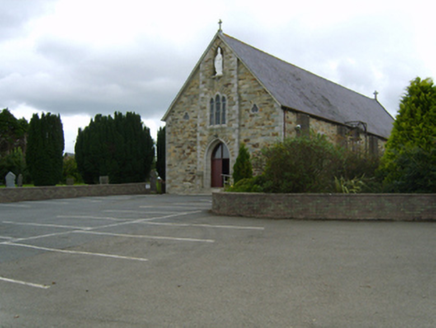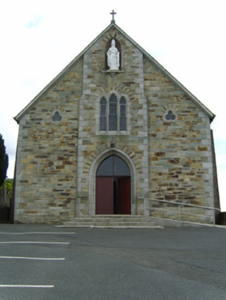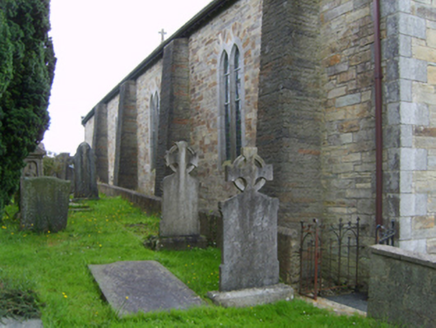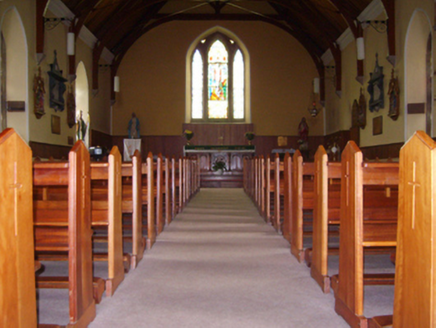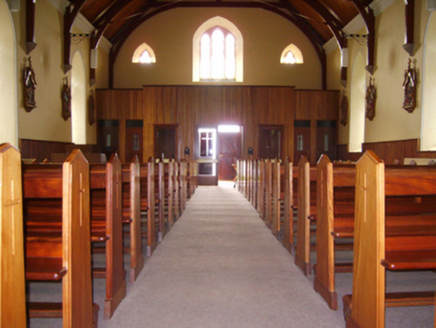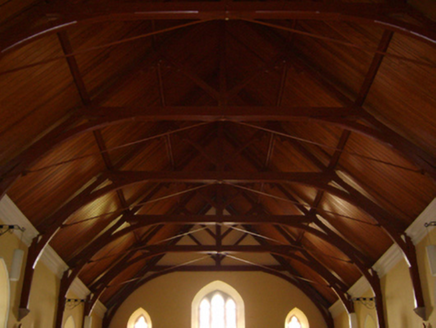Survey Data
Reg No
15702041
Rating
Regional
Categories of Special Interest
Architectural, Artistic, Historical, Social, Technical
Original Use
Church/chapel
In Use As
Church/chapel
Date
1865 - 1875
Coordinates
303312, 142765
Date Recorded
13/08/2007
Date Updated
--/--/--
Description
Detached four-bay double-height single-cell Catholic church, built 1870-1; dedicated 1871, on a rectangular plan with abbreviated single-bay full-height buttressed breakfront to entrance (west) front. Stabilised, 1961, producing present composition. Renovated, 1968, with sanctuary reordered. Replacement pitched slate roof with roll moulded clay ridge tiles, cut-granite coping to gable (east) on cut-granite "Cavetto" corbel kneelers with Cross finial to apex, and uPVC rainwater goods on timber eaves boards on "Cavetto"-detailed exposed timber rafters. Part repointed tuck pointed snecked rubble Knockavocka stone battered walls with cut-granite flush quoins to corners. Lancet window openings in bipartite arrangement with cut-granite surrounds having concave reveals framing fixed-pane fittings having stained glass margins centred on leaded stained glass roundels. Lancet "Trinity Window" to chancel (east) with cut-granite block-and-start surround having chamfered reveals framing storm glazing over fixed-pane fittings having stained glass margins centred on leaded stained glass panels. Pointed-arch door opening to entrance (west) front approached by flight of four cut-granite steps with cut-granite block-and-start surround having chamfered rebated reveals framing replacement timber boarded or tongue-and-groove timber panelled double doors having overlight. Lancet "Trinity Window" to gable with cut-granite block-and-start surround having chamfered reveals framing fixed-pane fittings having stained glass margins centred on leaded stained glass roundels. Interior including vestibule (west); square-headed door opening into nave with replacement glazed timber double doors; full-height interior open into roof with frosted glass "Trinity Window" (west), carpeted central aisle between replacement timber pews (1968), timber boarded or tongue-and-groove timber panelled wainscoting supporting timber dado rail, paired Gothic-style timber stations between frosted glass windows with pair of stained glass memorial windows (1898), pair of cut-limestone Classical-style wall monuments (ob. 1863; 1889), herring bone-pattern timber parquet stepped dais to sanctuary (east) reordered, 1968, with trefoil-detailed timber panelled altar below stained glass memorial "Trinity Window" (----), and exposed braced strutted collared timber roof construction on cruciform-detailed cut-granite corbels with wind braced timber boarded or tongue-and-groove timber panelled ceiling on moulded plasterwork cornice. Set in relandscaped grounds.
Appraisal
A church erected under the aegis of Reverend Henry Williams CC (1840-82), and to a design attributed to John Kelly (fl. 1860-71) of Gorey (DIA), representing an integral component of the later nineteenth-century built heritage of County Wexford with the architectural value of the composition, one evoking favourable comparisons with the earlier Saint David's Catholic Church (1860-1), Oilgate (see 15703221), suggested by such attributes as the compact rectilinear "barn" plan form, aligned along a liturgically-correct axis; the construction in a green- and ochre-coloured Knockavocka stone offset by silver-grey granite dressings not only demonstrating good quality workmanship, but also producing a pleasing palette; the slender profile of the coupled openings underpinning a "medieval" Gothic theme with the chancel defined by an elegant "Trinity Window"; and the high pitched roof shorn of its once eye-catching bellcote. Having been well maintained, the elementary form and massing survive intact together with quantities of the historic or original fabric, both to the exterior and to the interior reordered (1968) in accordance with the liturgical reforms sanctioned by the Second Ecumenical Council of the Vatican (1962-5) where contemporary joinery; wall monuments commemorating Reverend Edward Doyle (d. 1863) and Reverend Thomas Connick (d. 1889); and a vibrant "East Window" donated by Myles O'Brien 'of Monageer', all highlight the artistic potential of the composition: meanwhile, an exposed timber roof construction pinpoints the engineering or technical dexterity of a church forming part of a neat self-contained group alongside a much modified parochial house (1846) with the resulting ecclesiastical ensemble making a pleasing visual statement in a rural village street scene.
